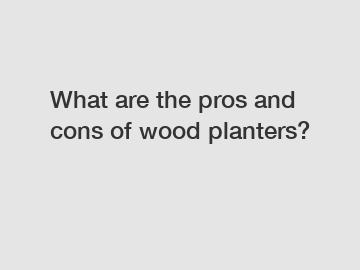What are the pros and cons of wood planters?
What are the pros and cons of wood planters?
Wood planters are a popular choice among gardeners and homeowners due to their natural beauty and versatility. However, like any other material, they also have their own set of advantages and disadvantages.
One of the main pros of wood planters is their aesthetic appeal. The natural warmth and texture of wood can complement any outdoor space and add a touch of elegance to the surroundings. Additionally, wood planters offer a wide range of design options as they can be easily painted or stained to match the desired color scheme or style. This allows gardeners to customize their planters according to their preference, making them a great choice for those who value personalization.

Another benefit of wood planters is their ability to regulate moisture for plants. Wood is a natural material that can absorb excess moisture from the soil, preventing waterlogged conditions that can lead to root rot. At the same time, it can also release moisture back into the soil when needed, ensuring a balanced and healthy environment for plant growth. This moisture regulation property of wood planters can be particularly beneficial for plants that require consistent moisture levels, such as certain herbaceous perennials and vegetables.
Moreover, wood planters are often praised for their durability. When properly maintained and treated, they can withstand the test of time and resist decay caused by exposure to the elements. However, it is important to note that not all types of wood are equally durable. Some wood species, such as cedar or redwood, are naturally more resistant to rot and decay due to their high content of natural preservatives. These types of wood are often recommended for outdoor applications, including planters, as they can ensure a longer lifespan for the containers.
Despite the numerous advantages, wood planters also have some drawbacks that should be considered. One of the main cons is their susceptibility to insect infestations. Certain wood species, such as pine or fir, are more prone to insect attacks and can be damaged by wood-boring pests like termites or carpenter ants. To mitigate this risk, it is essential to choose a wood species with natural insect repellent properties or consider using a protective treatment against pests.
Furthermore, wood planters require regular maintenance to preserve their appearance and structural integrity. They need to be periodically sealed or treated with a weather-resistant coating to protect them from moisture damage, fading, and warping. Neglecting proper maintenance can lead to premature deterioration and decrease the lifespan of the planters.
In conclusion, wood planters offer numerous advantages such as their aesthetic appeal, ability to regulate moisture, and durability. However, they do come with drawbacks including susceptibility to insect infestations and the need for regular maintenance. Considering these pros and cons, it is important for gardeners and homeowners to weigh their preferences and requirements before choosing wood planters for their outdoor spaces.
If you want to learn more, please visit our website round plant saucers wholesale, custom planter supplier, plant saucers wholesale.

Comments